Are you a Slacker? And if not, are you thinking of becoming one?
If this question calls forth glorious images of quitting your job, donning flannel, and moving to Portland to pursue your full-time underwater basket weaving career — let me clarify.
Slack, the predominant team collaboration tool, currently boasts over two million active users and half a million subscribers. Arriving hot on the scene some two years ago, the software transformed team communications and replaced email as the preferred means of team dialogue. Being able to unite increasingly remote workers and distributed teams across non-standard work hours made working life easier than previously imagined. Modern teams enjoyed app integrations, mobile usability, and custom workflows. And right on time – there was lots of pain in team communication area.
As the industry frontrunner, Slack’s a choice. But it’s not perfect. In his widely circulated 2015 article, “Slack, I’m breaking up with you,” author Sam Hulick cites his gripes with Slack, chiefly that messaging volume and app switching are killing his productivity. In his words,
“Instead of providing a solution to the email distraction, Slack has just replaced it.”
Is there a better way? Do you even want one? Maybe you’ve gone Slack and will never go back. That’s what we’re discussing today: how to get the most out of your team collaboration tool.
First, this post will talk about the 7 best ways to use Slack internally. This way you can cut down on unnecessary distractions and maximize your Slack experience.
Next, we’ll take a peek at how two competitors in the the team collaborations space – Ryver and Samepage – are competing for Slack’s user base with welcome improvements.
All platforms are similar in that they’ve collapsed the use of email between team members and improved project synthesis, but there are a few outstanding difference to know.
Once we’ve covered Slack hacks we’ll look at how these three contending platforms stack up against another and can provide your business with the ideal communication solution going into this new year.
7 Ways to Make the Most of Slack
#1 Customize Channel Notifications
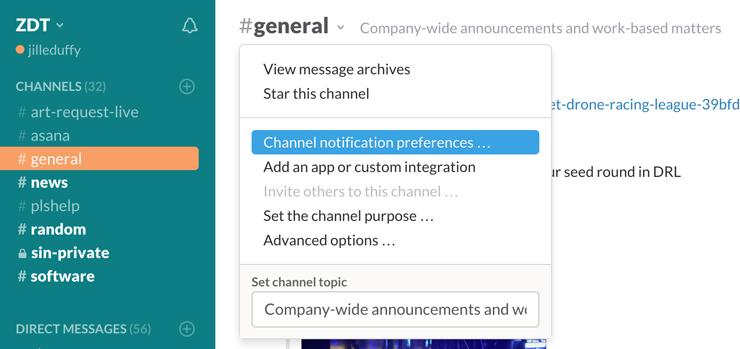
(Source)
We use Slack to be more productive right?
But not all channels are created equal and not all deserve equal attention. If you’re looking to minimize notification volume from @everyone shout outs, you can choose to exclude notifications for keywords and phrases in certain channels. Simply click on the given channel, then tap the “Channel notification preference” header and make the time-saving changes.
This is the first thing we suggest you do!
#2 Get Keyword Notifications

(Source)
Again, adjusting your notifications will save you time and boost productivity in Slack. By prioritizing certain phrases or keywords, you make sure to directly receive all relevant messaging. Go to “Preference” and then to “Notification Settings.” Scroll to the “Highlight Words” sections – now add words or phrases you want to trigger alerts when used by anyone.
When you shut off certain notifications, but you know something about marketing or promotion is important to you because you may be the VP of Marketing, this helps you get notified on discussions around these topics.
#3 Use @Everyone and @Channel Wisely
Slack etiquette can take time to grasp, but using callouts sparingly is crucial. Too many callouts defeats the purpose of Slack, as these messages function like an email blast and drain everyone’s attention. Fostering a culture of responsibility around @everyone and @channel can save your team heaps of time.
This should be on your onboarding with your team. I’ve seen Slack channels where the admins of communities keep abusing the @everyone and @channel which really annoys me since Slack is also installed on my phone.
#4 Limit Your Channels
Try to cut down on your total channels. Helpful when done smartly, overwhelming when overdone, Slack channels are best when used in moderation.
“Limit the channels your team creates. Although it’s helpful to delineate by project or topic, having too many chances to check can get confusing. Try for no more than six or eight channels company wide. Also, use “@” tags for action items. That way, in addition to scanning channels to keep up to date, team members will get notifications as needed.” — Brittany Hodak, ZinePak
We’re in the midst of cutting down our channels as well as we went trigger happy with creating almost 20+ channels, and it becomes mind numbing to determine which channel to really post things in.
#5 Add a Reminder
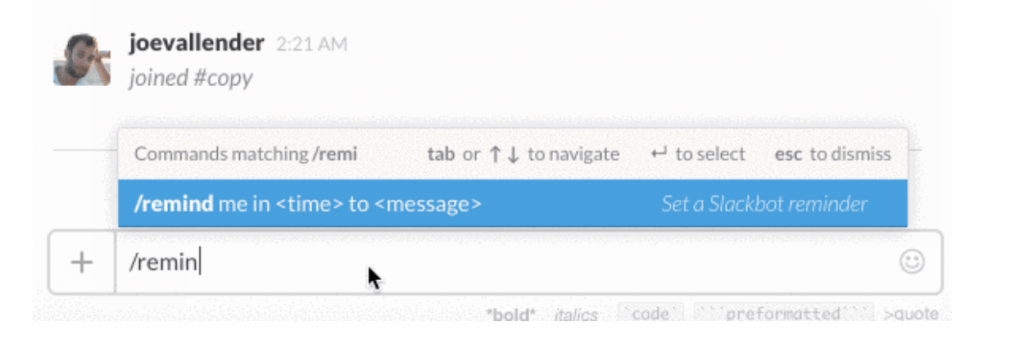
(Source)
With so many messages, remembering sure to follow-up gets increasingly difficult. Fortunately, the Slackbot reminder function sends you a message or a task when you need it.
For a shortcut, type “/reminder” and Slack will prompt you to fill the date and time. No more missed anything! Alternatively, beside each message if you click on the show more action icon (three dots horizontally) you can have that message be reminded in a specific amount of time. This way, you won’t forget about it, or something you need to snooze to be done later.
#6 Tag Colleagues for Fast Responses
The Slack interface can get crowded with all that communication whizzing by. Reach out to specific colleagues by tagging them in messages – you can expect a quicker response and better productivity all around.
“It’s very simple, but extremely effective. By tagging people in your messages, you’re more able to hold them accountable for a response. As chat rooms typically get filled with a lot of conversation, it’s important for people to know when they’re being spoken to, rather than when they’re just reading a statement.” — Kenny Nguyen, Big Fish Presentations
If we need a response from a team member or we need to ensure that person needs to read this part, we always @name so that they will always get a notification about this.
#7 Use Search Modifiers
If you’ve not found the search modifiers, a simple process like finding previous correspondence and materials can become a Herculean task. For example, “from: team member” finds messages from any colleague, and “in: channel” locates a keyword inside a channel. Here’s a full list of time-saving search modifiers including:
- in:
- from:
- has:
- before:
- after:
- on:
- during:
… and how to use them properly.
How Do Ryver and Samepage Compare with Slack?
As we’ve seen, getting creative and active with team collaboration tools can smooth the transition from prospect to customer, customer to satisfied customer. But “collaboration overload” is a real thing.
Do the alerts keep dragging you into the app? Fielding too many messages from Slack groups? Not getting responses back quickly enough? Are messages incoming without any sense of priority and making you switch from your task back into Slack?
Such productivity impediments can make you question your choice of platform.
If this sounds like you – or you’re just diving into team collaboration software for the first time – you want more. Or at least some perspective.
Thankfully, on our team we have multiple team members that have experienced all 3 + HipChat, so we can speak on some of the key differences between the platforms, so you get a choice in the matter. And the tactics we discussed above still apply to any of these platforms.
Ryver vs. Slack
“Slack and Ryver share a lot of similarities. Where Slack breaks down different conversation streams in “channels,” Ryver has “forums.” Syncing for both tools is at the server level. Unlike Slack, Ryver allows you to invite outside collaborators — or “guests” — into forums.” — David Coleman, author of Collaboration 2.0 and “42 Rules for Successful Collaboration”
Ryver models itself after Slack, but offers variable conversation streams to minimize the messaging overwhelm. Ryver users “Post” to forums when participating in a large group discussion, such as between customers and partners, advisors and investors, vendors, etc. “Teams” are for private discussions just between select individuals.
Both communication formats allow you invite members and guests, like Slack, though Slack’s free version limits your ability to add guests.
The significant difference between Slack and Ryver significantly is the Chat function. Slack is a straight chat while Ryver offers the same chat but also provides a threaded Facebook-esque topic-based discussion for larger discussions.
For example, you can “promote” a discussion from your product development team to the larger forum of the company when need be, and only when needed. These promoted posts are best for groups, allowing for a wider discussion around topic-based ideas.
Slack lacks the promotional ability in their chat stream, as all communications happen at a single chat-wide level.
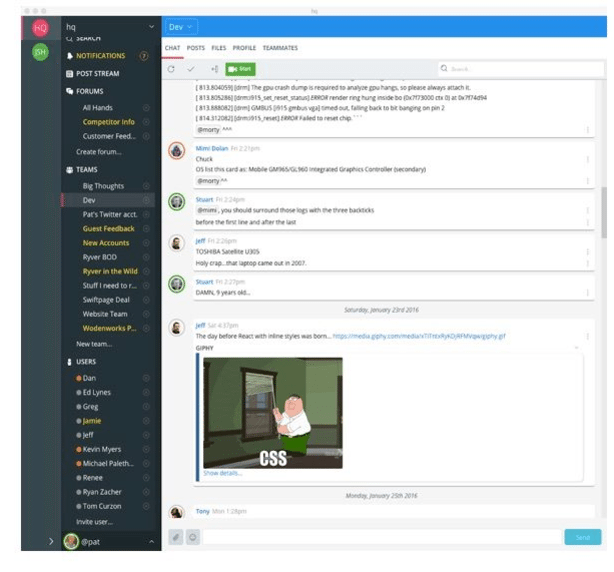
(Source)
Chat in Ryver, shown adding outside multimedia objects such as images, videos, tweets, or emails.
Ryver’s Chat is best for one-to-one communications or smaller teams, but like Slack, can get out of hand when different people jump in to share their opinions.
If a chat grows to 10 plus people, expect the resulting torrent to hamper productivity and push down key conversations.
By segmenting the communication strands, Ryver helps keep messaging volume at bay and segmented to the proper channel. If someone needs to offer input, they can jump into the discussion – and opt-out – at any time. Newcomers can catch up by reading the old discussions on a Facebook wall-type of interface. The posts also allow conversations to extend for longer timeframes.
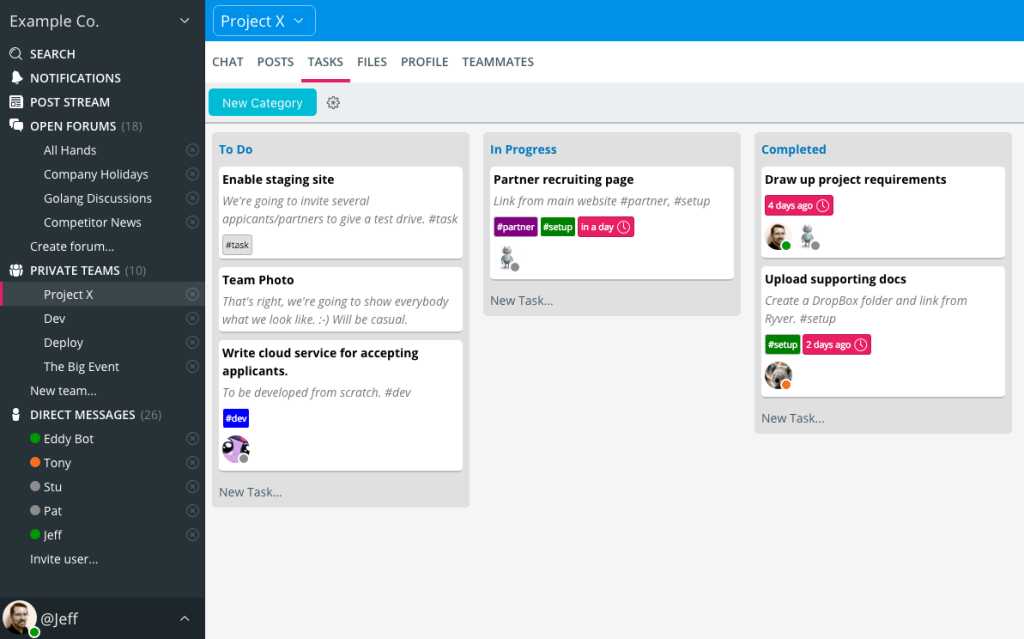
(Source)
The same can’t be said of Slack, if you’re using the free version. The unpaid Slack experience curbs messaging memory at 10,000 messages and so discussion threads begin to unravel after a given amount of dialogue.
Ryver offers unlimited messaging and unlimited storage. Unlike Slack, Ryver lets you assign tasks, set due dates, fill your calendar, attach files, and delegate what’s assigned to you through the Task Manager interface seen above.
Integrations that you’d expect from Slack are roughly the same, and Ryver will also import all your Slack files and data structures. Though the UI is not as pretty as Slack in our eyes, Ryver is 100% free.
Samepage vs. Slack
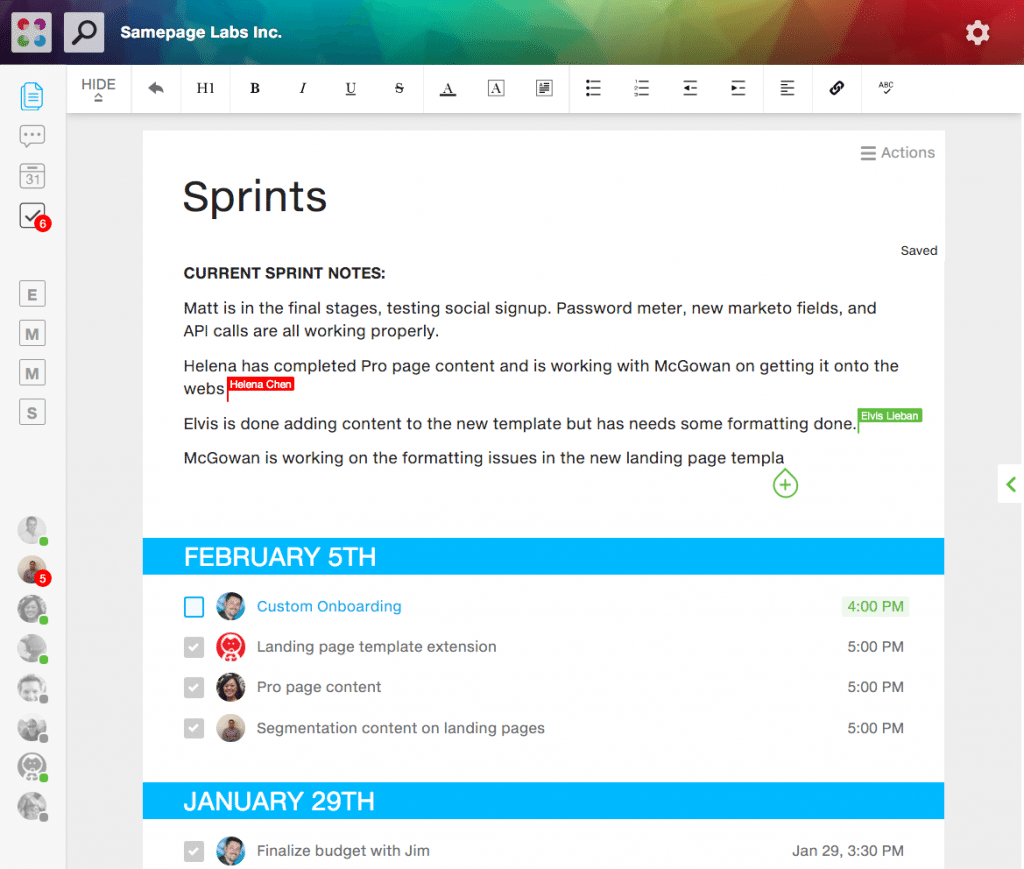
(Source)
Fresh from being named the G2 Crows High Performer of 2016, Samepage positions itself as a chat-centric work and collaboration platform with improved Slack-like features. With messaging, video chat, and file sharing built into the platform, Samepage wants to help you create ideas within the app.
The newcomer lets you create a document within the platform right alongside your chat, so you can keep the ideas flowing and get things done without interruption.
Being able to work directly from inside the app is a definite change, allowing for better productivity and an unfragmented mindset through the workflow.
Aside from this one essential difference, Samepage offers a set of features that Slack does not:
- Direct file editing allows you to save and edit documents from within the platform
- Real-time collaboration allows content creation and editing in the now
- Version control lets you keep and revert to revisions of past documents
- Task lists makes it easy to create to-do lists, add task details, and delegate to anyone
- View “My Tasks” to stay up to date on all your projects
- Track the team task list
- Calendar keeps all events and dates in one central location
- Sub-teams allow groups within groups to collaborate
- Page chat allows conversation right alongside your page
- Add HTML embed codes to share rich content
Overall, Samepage is a more of a collaborative / project management tool than a communications tool from what we’ve experience, but then again, isn’t that the best of both worlds? We use Slack for communications and Trello for project management currently.
[optin-monster-shortcode id=”aggfgt9un1tfwjnw”]
Over to You
Time will determine which team collaboration platforms will dominate. While Slack has the momentum and is the industry leader amongst some 175 total competitors, Ryver and Samepage have entered the space with answers to Slack users pain points, mainly fragmented work and unceasing interruptions.
Ryver takes aim at reducing notifications overwhelm with their distinct Chat and Post functions. By creating two options for discussions, Chats for smaller discussion and Posts in the Forum for larger, Ryver hopes to reduce user’s need to tune into every word and mention in circulation. Topic-specific threads keep pings to a minimum while size-appropriate message-sharing can drastically cut down on notification volume.
Samepage focuses upon unifying the communication and workflow into one platform. Instead of having to leave your app and check in to stay updated with developments, work within and message within the app concurrently. When task and communication management are centralized, you needn’t split your attentions.
For us, we’ve integrated Slack into our company way before Ryver and Samepage existed, we were early adopters. Now with many of our team members and our onboarding system has been nicely set and accustomed to, so Slack works perfectly for us. With some global organizations I’m a part of, we use Samepage and it’s perfect for that. And another company that I sit on the board of, uses Ryver and it’s perfect for that.
As we can see, there is no one size fits all tool. Options are available for those seeking the optimum team collaboration tool. Which style suits your company is left for you to decide.
What’s your priority when considering a team collaboration tool?
